Sony SDT-S9000, SDT-S7200, SDT-S5200, SDT-S7000, SDT-S5000 Operators Manual
...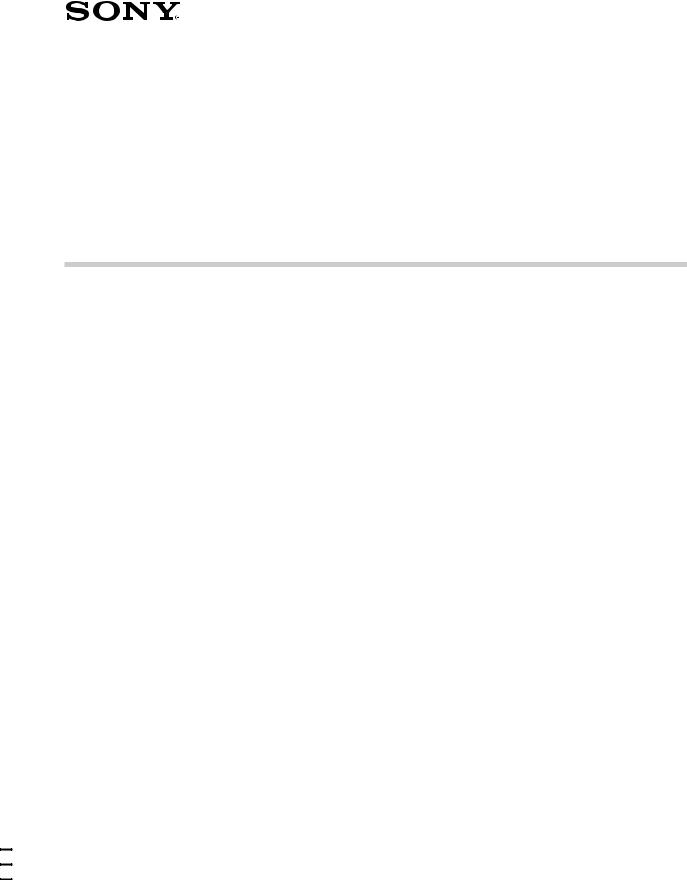
3-798-026-33(1)
SDT-S9000/S7000/S7200/S5000/S5200/S4000E/S2000E
DDS Drive Unit
Operator’s Guide ––––––––––––– page 2
Mode d’emploi –––––––––––––––– page 29
Bedienungsanleitung –––––––– Seite 55
Guía del usuario –––––––––––––– página 81
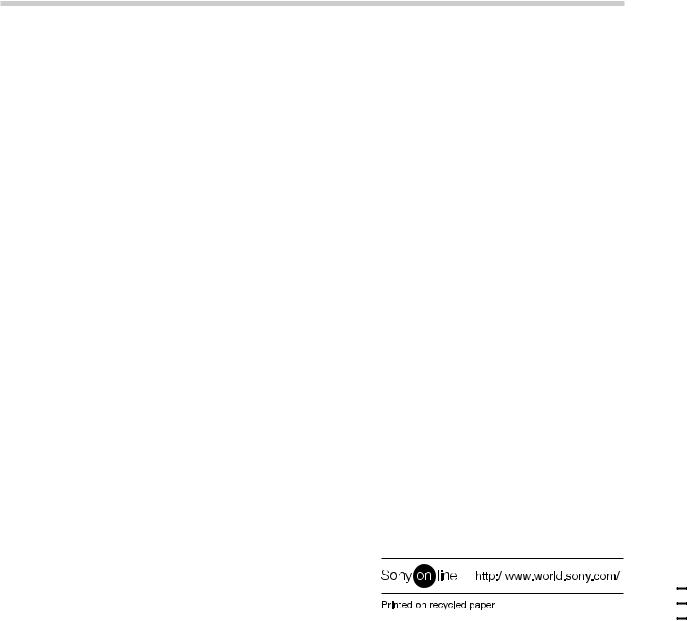
SDT-S9000/S7000/S7200/S5000/S5200/S4000E/S2000E
DDS Drive Unit
User's Guide
Mode d'emploi
Benutzerhandbuch
Guía del usuario
Sony Corporation Printed in Japan ã 1996

Safety Regulations
Owner's Record
The model and serial numbers are located on the bottom. Record the serial number in the space provided below.
Refer to them whenever you call upon your Sony dealer regarding this product.
|
Model No. |
|
Serial No. |
|
|
|
|
|
|
|
|
Information
WARNING
To prevent fire or shock hazard, do not expose the unit to rain or moisture.
To avoid electrical shock, do not open the cabinet.
Refer servicing to qualified personnel only.
For the customers in the U.S.A.
You are cautioned that any changes or modifications not expressly approved in this manual could void your authority to operate this equipment.
WARNING
Note: This equipment has been tested and found to comply with the limits for a Class B digital device, pursuant to Part 15 of the FCC Rules. These limits are designed to provide reasonable protection against harmful interference in a residential installation. This equipment generates, uses and can radiate radio frequency energy and, if not installed and used in accordance with the instructions, may cause harmful interference to radio communications. However, there is no guarantee that interference will not occur in a particular installation. If this equipment does cause harmful interference to radio or television reception, which can be determined by turning the equipment off and on, the user is encouraged to try to correct the interference by one or more of the following measures:
•Reorient or relocate the receiving antenna
•Increase the separation between the equipment and receiver.
•Connect the equipment into an outlet on a circuit different from that to which the receiver is connected.
•Consult the dealer or an experienced radio/TV technician for help.
2

NOTICE
THIS NOTICE IS APPLICABLE FOR USA AND CANADA ONLY.
If shipped to USA, use the UL LISTED power cord specified below for 220-240 V operation.
If shipped to CANADA, use the CSA CERTIFIED power cord specified below for 220-240 V operation.
DO NOT USE ANY OTHER POWER CORD
Plug Cap |
Tandem blade with ground pin. |
|
(NEMA 6-15P Configuration) |
Cord |
Type SVT or SJT, three 16 or 18 AWG wires. |
Length |
Maximum 14.7 feet (4.5m) |
Rating |
Minimum 10A, 250 V |
NOTICE
This notice is applicable for countries other than USA and Canada.
In the countries other than USA and Canada, use the power cord set approved by the appropriate testing organization for the specific countries where this unit is to be used.
English
3

Table of Contents |
|
How to Use this Guide |
6 |
Part 1. Introduction |
7 |
About DDS Drives |
7 |
Features ........................................................................................................... |
7 |
Useable Cartridges .......................................................................................... |
9 |
System Components........................................................................................ |
9 |
Part Names and Functions |
10 |
Front panel ..................................................................................................... |
10 |
Rear Panel ..................................................................................................... |
12 |
Part 2. Preparation |
13 |
Supplied Items |
13 |
Interconnections |
13 |
SCSI ID Setting |
14 |
Configuration Switches Setting |
14 |
Part 3. Operation |
16 |
How to use the DDS Drive |
16 |
Cartridge Removal ......................................................................................... |
17 |
Part 4. Care and Maintenance |
18 |
Taking Care of the Drive |
18 |
Safety Considerations .................................................................................... |
18 |
Avoiding Damage ........................................................................................... |
18 |
Taking Care of Cartridges |
20 |
Use Precautions............................................................................................. |
20 |
Storage Precautions ...................................................................................... |
20 |
Head Cleaning |
21 |
How to Clean ................................................................................................. |
21 |
4

Appendix |
22 |
Specifications (SDT-S9000) |
22 |
Specifications (SDT-S7000) |
23 |
Specifications (SDT-S7200) |
24 |
Specifications (SDT-S5000) |
25 |
Specifications (SDT-S5200) |
26 |
Specifications (SDT-S4000E) |
27 |
Specifications (SDT-S2000E) |
28 |
5

How to Use this Guide
This Guide describes the DDS Drive Unit SDT-S9000/S7000/S7200/S5000/ S5200/S4000E/S2000E , and how to take care of it. Please read it carefully before using the unit, and keep it handy for future reference.
The Guide consists of four parts, plus the specifications. Refer to the parts that relate to your use of the drive.
Part 1 describes the features of the drive, its system components, and the name and function of each part.
Part 2 describes the necessary connections between the drive and the host computer. If other SCSI devices are being used, you may need to change the SCSI ID setting. Read this part if you are installing the drive.
Part 3 describes how to use the drive, including how to turn it on, and how to insert and remove cartridges. Read this part if you are going to operate the drive.
Part 4 describes how to take care of the drive and cartridges, and how to clean the drive heads. Read this part before using the drive.
The Specifications appendix provides the major specifications of the SDT-
S9000/S7000/S7200/S5000/S5200/S4000E/S2000E.
6


 Part 1. Introduction
Part 1. Introduction
About DDS Drives
The SDT-S9000 is an external DDS drive unit that uses data cartridges conforming to the DDS-3 format. The SDT-S7000, SDT-S7200, SDT-S5000 and SDT-S5200 are external DDS drive units that use data cartridges conforming to the DDS-2 format. The SDT-S4000E and SDT-S2000E are external DDS drive units that use data cartridges conforming to the DDS-1 format. The SDT-S9000 supports DDS-1, DDS-2 and DDS-3 formats.The SDT-S7000, SDT-S7200, SDT-S5000 and SDT-S5200 support both DDS-1 and DDS-2 formats. The SDT-S4000E and SDT-S2000E support only DDS- 1 format.
Features
The DDS Drive Unit SDT-S9000 has the following features:
•The Digital Data Storage format provides a huge data storage capacity on DDS-1/DDS-2/DDS-3 data cartridges.
•Read After Write Function and third-level error correction code guarantee high data reliability.
•Data compression provides 24 gigabytes of storage on 125 m tape-length cartridge.*1
The native capacity is 12 gigabytes of storage on 125 m tape-length cartridge.
•Stored data are automatically checked for compression.
•The SCSI-2 (ANSI SCSI-2 X3T9.2/86-109 REV.10C) interface is fully supported for host computer access.
•Read/Write operation is available with both DDS-1, DDS-2 and DDS-3 format.
*1 This is assuming 2 : 1 compression ratio.
The degree of data compression attained while recording data varies according to system environment and data type.
Part 1. Introduction |
7 |
The DDS Drive Unit SDT-S7000/S7200/S5000/S5200 has the following features:
•The Digital Data Storage format provides a huge data storage capacity on DDS-1/DDS-2 data cartridges.
•Read After Write Function and third-level error correction code guarantee high data reliability.
•Data compression*1 provides 8 gigabytes of storage on 120 m tape-length cartridge.*2
The native capacity is 4 gigabytes of storage on 120 m tape-length cartridge.
•Stored data are automatically checked for compression.*3 The SDT-S5000 can read uncompressed data written by earlier-model drives.
•The SCSI-2 (ANSI SCSI-2 X3T9.2/86-109 REV.10C) interface is fully supported for host computer access.
•Read/Write operation is available with both DDS-1 and DDS-2 format.
*1
*2
*3
The SDT-S7200/S5200 is not equipped with data compression. This is assuming 2 : 1 compression ratio.
The degree of data compression attained while recording data varies according to system environment and data type.
With the SDT-S7000 and SDT-S5000.
The DDS Drive Unit SDT-S4000E/S2000E has the following features:
•The Digital Data Storage format provides a huge data storage capacity on DDS-1 data cartridges.
•Read After Write Function and third-level error correction code guarantee high data reliability.
•Data compression*1 provides 4 gigabytes of storage on 90 m tape-length cartridge.*2
The native capacity is 2 gigabytes of storage on 90 m tape-length cartridge.
•Stored data are automatically checked for compression.*3 The SDT-S4000E can read uncompressed data written by earlier-model drives.
•The SCSI-2 (ANSI SCSI-2 X3T9.2/86-109 REV.10C) interface is fully supported for host computer access.
*1
*2
*3
The SDT-S2000E is not equipped with data compression. This is assuming 2 : 1 compression ratio.
The degree of data compression attained while recording data varies according to system environment and data type.
With the SDT-S4000E only.
8 Part 1. Introduction
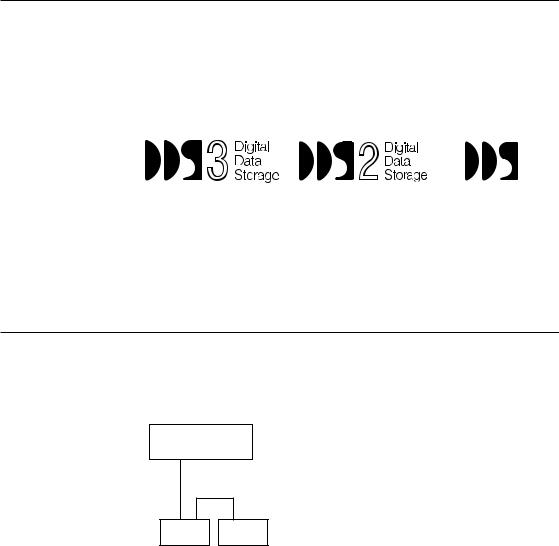
Useable Cartridges
Data cartridges used with the SDT-S9000 must be marked with the DDS-1, DDS-2 or DDS-3 logo. The SDT-S7000/S7200/S5000/S5200 can only be used with data catridges marked with the DDS-1 or DDS-2 logo and the SDT-S4000E/S2000E can only be used with data cartridges marked with the DDS-1 logo.
DDS-3 Logo |
DDS-2 Logo |
DDS-1 logo |
CAUTION:
Be sure to use only the cartridges designed specifically for DDS (do not use
DAT cartridges for music).
System Components
The SDT-S9000/S7000/S7200/S5000/S5200/S4000E/S2000E connects to the host computer via a SCSI-2 interface.
Host Computer
|
|
|
|
|
|
|
|
|
|
|
|
|
|
|
|
|
|
|
|
|
|
|
|
|
|
|
|
|
|
|
|
|
|
|
|
|
|
|
|
|
|
|
|
SDT-S9000/S7000/S7200/S5000/ |
|
|
Peripheral Devices |
|
|
|
|
|
|
|
|||||||||||
S5200/S4000E/S2000E |
|
|
|
|
|
|
|
|
|
||||||||||||
|
|
|
|
|
|
|
|
|
|
|
|
|
|
|
|||||||
(This Device) |
|
|
|
|
|
|
|
|
|
|
|
|
|
|
|
||||||
Figure 1-1. Example of System Components
Part 1. Introduction |
9 |

Part Names and Functions
Front panel
1
POWER |
BUSY TAPE STATUS |
EJECT |
7 6 5 4 3 2
Figure 1-2. Front panel
1DDS Data Cartridge Receptacle
See page 17 for information on inserting and removing a DDS data cartridge.
2EJECT Button
Push to remove a data cartridge from the drive.
3STATUS Indicator
Lights when an inserted cartridge is write-protected. This indicator also lights under the following conditions:
Drive needs cleaning: |
repeating long-on, short-off |
|
blinking. |
End of Tape during cleaning: |
repeating blinking (same on-off |
|
interval). |
Drive Malfunctioning: |
repeating short-on (once or twice), |
|
long-off blinking. |
|
|
4TAPE Indicator
When a DDS cartridge is installed, this indicator lights. This also lights under the following conditions:
Inserting and removing |
repeated blinking (same on-off |
a cartridge: |
interval). |
Cartridge deteriorated: |
alternating long-short blinking. |
|
|
10 Part 1. Introduction
5BUSY Indicator
Lights when data is being transferred through the SCSI interface. This indicator also lights under the following conditions:
|
Drive is reading or writing |
repeated blinking (same on-off |
|
normally: |
interval). |
|
High Humidity: *1 |
alternating long-short blinking |
|
|
(cartridge cannot be inserted). |
|
|
|
6 POWER Indicator |
|
|
|
Lights while the drive is on. |
|
7POWER Switch
Press to turn the drive on or off.
*1 With the SDT-S5000/S5200/S4000E/S2000E
Part 1. Introduction 11

Rear Panel
1
SCSI CONNECTOR
|
|
AC IN |
|
|
|
SCSI ID |
GND |
5 |
4 |
3 |
2 |
|
Figure 1-3. Rear Panel |
|
|
1AC IN Connector
Connect the supplied power cable here.
2GND (Ground) Terminal
Connect the ground terminals of other devices to the unit's frame ground.
3Rotary Selector Switch
SCSI ID selector.
4 Cooling Fan
5SCSI Connector
Connects to the SCSI bus connector of the host computer or another SCSI peripheral.
12 Part 1. Introduction
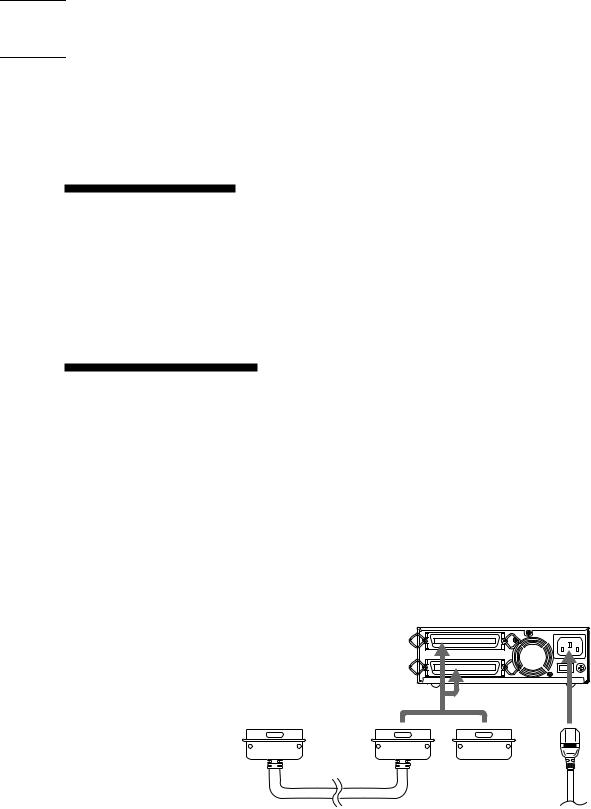

 Part 2. Preparation
Part 2. Preparation
After you confirm that you have all of the required accessories for your installation, connect the drive to the host computer, and select the SCSI ID with the rotary switch on the rear panel.
Supplied Items
When you first open the box, make sure it contains the following items.
Contact your supplier if anything is missing or broken.
•DDS Drive Unit
•Power Cable
•This Guide
Interconnections
The SCSI bus allows connection of up to seven peripherals to the host computer. Use a SCSI cable with a full-pitch connector.
Precautions
•Switch off the host computer and peripherals before connecting the SCSI cable.
•Make sure the SCSI connectors are pressed tightly together.
•If this unit is the last (or only) device on the SCSI bus, make sure to connect a SCSI bus terminator to the open connector.
•The total length of the SCSI cable(s) between the host computer and the last device should be less than 6 meters.*1
SCSI CONNECTOR
AC IN
SCSI ID GND
AC power
Figure 2-1 Interconnections
*1 When using high-speed data transfer with the SDT-S9000/S7000/S7200, it is recommended that total length of the SCSI cable not exceed 3m.
Part 2. Preparation 13
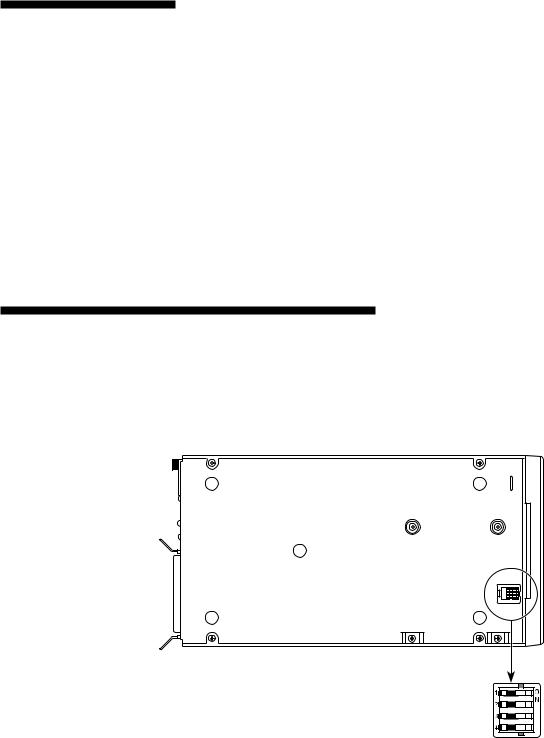
SCSI ID Setting
The SCSI ID is set by the rotary switch on the rear panel. Press the + or - buttons to move the number up or down, respectively.
As shipped from the factory, the SCSI ID is set to 0. Press the switch buttons, if necessary, to select the SCSI ID number you require.
Precautions
•The SCSI ID must be different from IDs of the other peripherals on the SCSI bus.
•As shipped from the factory, SCSI parity is enabled and Term power is ON. Since the terminating resistor inside the drive is disabled, a SCSI bus terminator must be connected to the SCSI bus before use.
•Before changing the SCSI ID setting, be sure to turn off the power with the POWER switch on the front panel.
Configuration Switches Setting *1
Sony SDT-S9000/S7000/S7200 has a set of configuration switches located on its bottom side (Fig 2-2). These drives can be made ready to run in major workstations by setting the configuration switches as shown in the following table.
*1 with the SDT-S9000/S7000/S7200
Fig2-2 SDT-S9000/S7000/S7200 Configuration swiches
14 Part 2. Preparation

SDT-S9000/S7000/S7200 Configuration Switch Settings for Unix
|
System |
Configuration |
||||||||||||
Host |
|
Unix |
SW Setting |
|||||||||||
|
|
|
|
|
|
|
|
|
|
|
|
|
|
|
PC-based WS |
|
SCO Unix |
|
|
|
|
|
|
|
|
|
|
|
|
|
|
|
|
|
|
|
|
|
|
|
|
|
||
|
|
|
|
|
|
|
|
|
|
|
|
|
||
|
|
|
|
|
|
|
|
|
|
|
|
|||
|
|
|
|
|
|
|
|
|
|
|
|
|||
|
|
Xenix |
|
|
|
|
|
|
|
|
|
|
|
|
|
|
|
|
|
|
|
|
|
|
|
|
|
|
|
|
|
|
|
|
|
|
|
|
|
|
|
|
|
|
|
|
|
|
|
|
|
|
|
|
|
|
|
||
|
|
|
|
|
|
|
|
|
|
|
|
|
||
|
|
|
|
|
|
|
|
|
|
|
|
|
|
|
|
|
|
|
|
|
|
|
|
|
|
|
|
|
|
Digital WS |
|
|
|
|
|
|
|
|
|
|
|
|
|
|
|
|
|
|
|
|
|
|
|
|
|
|
|
|
|
|
|
|
|
|
|
|
|
|
|
|
|
|
|
|
|
|
|
|
|
|
|
|
|
|
|
|
|
|
|
|
|
|
|
|
|
|
|
|
|
|
|
|
|
|
|
|
|
|
|
|
|
|
|
|
|
|
|
|
|
|
|
|
|
|
|
|
|
|
|
|
|
|
|
|
|
|
|
|
|
|
|
|
|
|
|
|
|
|
|
|
|
|
|
|
|
|
|
|
|
|
|
|
|
|
|
|
|
|
|
|
|
|
|
|
|
|
|
|
|
|
|
|
|
|
|
|
|
|
|
|
|
|
|
|
|
|
|
|
|
|
|
|
|
|
|
|
|
|
|
Sun WS |
|
Solaris 2.X |
|
|
|
|
|
|
|
|
|
|
|
|
|
|
|
|
|
|
|
|
|
|
|
|
|
||
|
|
|
|
|
|
|
|
|
|
|
|
|
||
|
|
|
|
|
|
|
|
|
|
|
|
|
||
|
|
|
|
|
|
|
|
|
|
|
|
|||
|
|
|
|
|
|
|
|
|
|
|
|
|
|
|
|
|
|
|
|
|
|
|
|
|
|
|
|
|
|
|
|
|
|
|
|
|
|
|
|
|
|
|
|
|
|
|
|
|
|
|
|
|
|
|
|
|
|
|
|
|
|
|
|
|
|
|
|
|
|
|
|
|
|
|
|
|
|
|
|
|
|
|
|
|
|
|
|
|
|
|
|
|
|
|
|
|
|
|
|
|
|
|
|
|
Sun WS |
|
Sun OS 4.1.X |
|
|
|
|
|
|
|
|
|
|
|
|
|
|
|
|
|
|
|
|
|
|
|
|
|
||
|
|
|
|
|
|
|
|
|
|
|
|
|
||
|
|
|
|
|
|
|
|
|
|
|
|
|
||
|
|
|
|
|
|
|
|
|
|
|
|
|||
|
|
|
|
|
|
|
|
|
|
|
|
|
|
|
|
|
|
|
|
|
|
|
|
|
|
|
|
|
|
|
|
|
|
|
|
|
|
|
|
|
|
|
|
|
|
|
|
|
|
|
|
|
|
|
|
|
|
|
|
|
|
|
|
|
|
|
|
|
|
|
|
|
|
|
|
|
|
|
|
|
|
|
|
|
|
|
|
|
|
|
|
|
|
|
|
|
|
|
|
|
|
|
|
|
IBM RS/6000 WS |
|
AIX |
|
|
|
|
|
|
|
|
|
|
|
|
|
|
|
|
|
|
|
|
|
|
|
|
|
||
|
|
|
|
|
|
|
|
|
|
|
|
|
||
|
|
|
|
|
|
|
|
|
|
|
|
|
||
|
|
|
|
|
|
|
|
|
|
|
|
|||
|
|
|
|
|
|
|
|
|
|
|
|
|
|
|
|
|
|
|
|
|
|
|
|
|
|
|
|
|
|
|
|
|
|
|
|
|
|
|
|
|
|
|
|
|
|
|
|
|
|
|
|
|
|
|
|
|
|
|
|
|
|
|
|
|
|
|
|
|
|
|
|
|
|
|
|
|
|
|
|
|
|
|
|
|
|
|
|
|
|
|
|
|
|
|
|
|
|
|
|
|
|
|
|
|
IBM RS/6000 WS |
|
AIX |
|
|
|
|
|
|
|
|
|
|
|
|
|
|
|
|
|
|
|
|
|
|
|
|
|
||
|
|
|
|
|
|
|
|
|
|
|
|
|
||
|
|
|
|
|
|
|
|
|
|
|
|
|||
|
|
|
|
|
|
|
|
|
|
|
|
|||
|
|
|
|
|
|
|
|
|
|
|
|
|
|
|
|
|
|
|
|
|
|
|
|
|
|
|
|
|
|
|
|
|
|
|
|
|
|
|
|
|
|
|
|
|
|
|
|
|
|
|
|
|
|
|
|
|
|
|
|
|
|
|
|
|
|
|
|
|
|
|
|
|
|
|
|
|
|
|
|
|
|
|
|
|
|
|
|
|
|
|
|
|
|
|
|
|
|
|
|
|
|
|
|
|
HP WS |
|
HP-UX |
|
|
|
|
|
|
|
|
|
|
|
|
|
|
|
|
|
|
|
|
|
|
|
|
|
||
|
|
|
|
|
|
|
|
|
|
|
|
|
||
|
|
|
|
|
|
|
|
|
|
|
|
|
||
|
|
|
|
|
|
|
|
|
|
|
|
|||
|
|
|
|
|
|
|
|
|
|
|
|
|
|
|
|
|
|
|
|
|
|
|
|
|
|
|
|
|
|
|
|
|
|
|
|
|
|
|
|
|
|
|
|
|
|
|
|
|
|
|
|
|
|
|
|
|
|
|
|
|
|
|
|
|
|
|
|
|
|
|
|
|
|
|
|
|
|
|
|
|
|
|
|
|
|
|
|
|
|
|
|
|
|
|
|
|
|
|
|
|
|
|
|
|
SGI WS |
|
IRIX |
|
|
|
|
|
|
|
|
|
|
|
|
|
|
|
|
|
|
|
|
|
|
|
|
|
||
|
|
|
|
|
|
|
|
|
|
|
|
|
||
|
|
|
|
|
|
|
|
|
|
|
|
|
||
|
|
|
|
|
|
|
|
|
|
|
|
|||
|
|
|
|
|
|
|
|
|
|
|
|
|
|
|
|
|
|
|
|
|
|
|
|
|
|
|
|
|
|
|
|
|
|
|
|
|
|
|
|
|
|
|
|
|
|
|
|
|
|
|
|
|
|
|
|
|
|
|
|
|
|
|
|
|
|
|
|
|
|
|
|
|
|
|
|
|
|
|
|
|
|
|
|
|
|
|
|
|
|
|
|
|
|
|
|
|
|
|
|
|
|
|
|
|
Part 2. Preparation 15
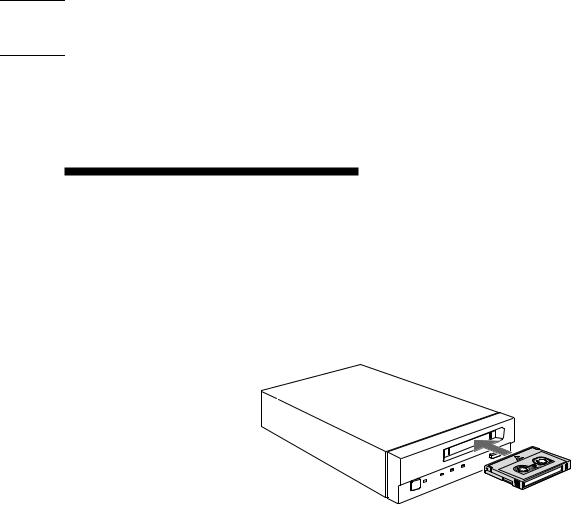

 Part 3. Operation
Part 3. Operation
This section describes how to use the DDS drive, and how to handle data cartridges.
How to use the DDS Drive
1Press the POWER switch on the front panel.
The POWER indicator should light, and the STATUS, BUSY and TAPE indicators should blink as the self-test is performed.
2When the three indicators stop blinking, you can insert a data cartridge as shown below. The TAPE indicator will blink, and if the cartridge is write-protected, the STATUS indicator will light.
Figure 3-1. Inserting a data cartridge
3Computer software controls the reading and writing of tapes. While reading or writing, the BUSY indicator blinks.
16 Part 3. Operation

Cartridge Removal
Press the EJECT button.
The cartridge ejects automatically.
Figure 3-2. Press the EJECT button
Caution
Do not push the EJECT button while the BUSY indicator is blinking: to do so may destroy data on the tape.
Part 3. Operation 17


 Part 4. Care and Maintenance
Part 4. Care and Maintenance
Taking Care of the Drive
Safety Considerations
■ Power
•Be sure to use only 100-240 V AC.
•Avoid plugging into the same outlet as high-current equipment like copiers or shredders.
■Power Cable Precautions
•Do not crush the cable or place heavy items on it. If the cable insulation appears worn or broken, do not use the cable.
•Always unplug the cable by holding the plug: never pull the cable itself, as it will break.
•If the drive is not being used for a long time, unplug the cable from the outlet.
Avoiding Damage
■ Avoid shock and vibration
Intense shock, such as from dropping the drive, will damage it.
■ Environmental considerations
Do not store or use the drive in locations subject to:
• |
high humidity |
• |
excessive dust |
• |
high temperature |
• |
intense vibration |
• |
direct sunlight |
• |
sudden changes in temperature |
■ Proper ventilation
To avoid overheating, install the drive where it will have free air circulation around the case, and do not cover it during operation. The drive can malfunction if the internal temperature rises too high.
■ Avoid sudden changes in temperature
If the drive is moved from a cool place to a warm place, or if the room temperature suddenly rises, moisture may condense inside the case. After a sudden change in temperature, wait at least one hour before turning the drive on. If the drive is turned on with condensation inside, and a cartridge is installed, the drive or the tape can be damaged.
18 Part 4. Care and Maintenance
■ When the Humidity sensor indicator is on
The drive contains a humidity sensor, which causes the BUSY indicator to blink when the humidity inside the case is too high (see page 10). If this occurs, reduce the humidity in the room with a dehumidifier or air conditioner, or by other means.*1
■ Abnormal occurrences
If the drive behaves abnormally, or if it begins to smell or smoke, immediately unplug it from the wall outlet and contact your supplier for assistance.
■ Cabinet cleaning
Wipe the cabinet with a soft dry cloth. For heavy dirt, wipe with a soft cloth moistened with a gentle liquid soap, then wipe again with a soft dry cloth. Do not use alcohol, paint thinner, bug sprays or other volatile solvents, as they can damage the finish.
*1 With the SDT-S5000/S5200/S4000E/S2000E.
Part 4. Care and Maintenance |
19 |
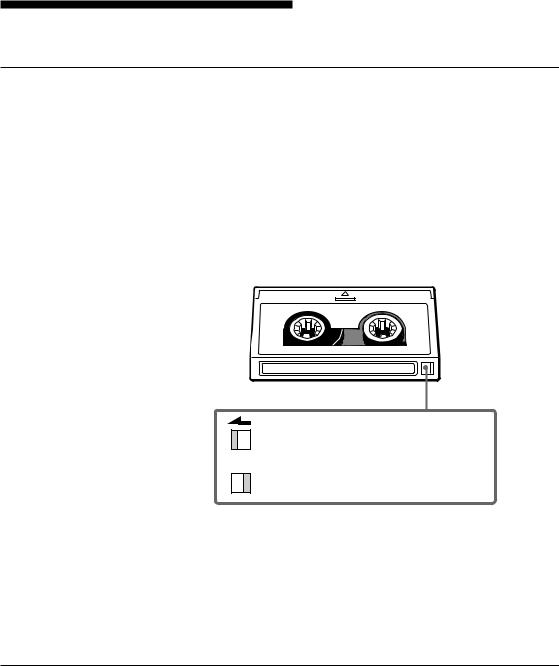
Taking Care of Cartridges
Use Precautions
•Avoid heavy vibration and dropping.
•The shutter on the face of the cartridge is opened automatically when it is inserted into the drive. Do not open the shutter by hand, as touching the tape may damage it.
•The cartridge was carefully aligned during assembly at the factory. Please do not try to open it or take it apart.
•The write-protect switch on the face of the cartridge prevents the tape from being written to or accidentally erased. If you do not need to write to the tape, move this switch to the write-protect position (in the direction of the arrow).
Using your fingernail, push the switch in the direction of the arrow to protect the tape from writing or accidental erasure.
Return the switch to its original position to re-enable writing.
Figure 4-1. Write-protect switch
•In case of a sudden change in temperature, condensation may interfere with reading and writing to a tape.
•Avoid unnecessary insertion and removal of cartridges if you do not need to write or read a tape.
•When finished using the drive, remove the cartridge.
Storage Precautions
•Keep cartridges in their cases when not in the drive.
•Avoid storing cartridges in dusty places, in direct sunlight, near heaters or air conditioners, or in humid locations.
•Do not place cartridges on the dashboard or in a storage tray in a car.
20 Part 4. Care and Maintenance

Head Cleaning
To keep the DDS drive in top condition, clean the head as needed, using the proper head cleaning cartridge (sold separately). When the head needs cleaning, the STATUS indicator will blink.
How to Clean
1Insert the head cleaning cartridge (DGD15CL) into the DDS Data cartridge receptacle. Cleaning starts automatically.
2After about 10 seconds, cleaning will stop and the cartridge will eject automatically.
One head cleaning cartridge can be used about 90 times.
Notice:
Do not rewind the cleaning cartridge and reuse it. When you reach the end of the cartridge, dispose of it and buy a new one.
Part 4. Care and Maintenance |
21 |


 Appendix
Appendix
Specifications (SDT-S9000)
■ Performance
Storage Capacity |
24 GB compressed |
|
(with 125 m DDS-3 tape)*1 |
|
12 GB uncompressed |
|
(with 125 m DDS-3 tape) |
Bit Error Rate |
less than 10-15 |
Data Transfer Rate |
1.18 MB/s uncompressed |
(TAPE) |
2.36 to 4.72 MB/s compressed |
Burst Data Transfer Rate |
5 MB/s maximum, asynchronous |
(SCSI) |
10 MB/s maximum, synchronous |
Initialize Time |
less than 3 seconds |
Load Time |
less than 24 seconds |
Unload Time |
less than 20 seconds |
Rewind Time |
less than 80 seconds (with 125 m tape) |
■ Operating Environment
Operating |
Temperature: |
10 to 35 °C |
|
Humidity: |
30 to 80% |
|
|
(no condensation) |
|
Maximum wet bulb temperature: 26 °C |
|
Non-Operating |
Temperature: |
-40 to +70 °C |
|
Humidity: |
10 to 90% |
■ Power Supply & Miscellaneous
Power Supply |
100 to 240 V AC, 50/60 Hz |
|
0.5 to 0.3 A |
Case Dimensions |
160 × 52.4 × 300 mm (W × H × D) |
|
(excluding protruding parts) |
Weight |
2.2 kg |
Accessories |
Power Cable (1) |
|
User's Guide (1) |
Specifications may be subject to change, in the interest of technological improvement, without notice or obligation.
*1 This is assuming 2 : 1 compression ratio.
The degree of data compression attained while recording data varies according to system environment and data type.
22 Appendix

Specifications (SDT-S7000)
■ Performance
Storage Capacity |
8 GB compressed |
|
(with 120 m DDS-2 tape) |
|
4 GB uncompressed |
|
(with 120 m DDS-2 tape) |
Bit Error Rate |
less than 10-15 |
Data Transfer Rate |
778 kB/s uncompressed |
|
1556 to 3112 kB/s compressed |
Burst Data Transfer Rate |
5 MB/s maximum, asynchronous |
|
10 MB/s maximum, synchronous |
Initialize Time |
less than 3 seconds |
Load Time |
less than 16 seconds |
Unload Time |
less than 20 seconds |
Rewind Time |
less than 80 seconds (with 120 m tape) |
■ Operating Environment
Operating |
Temperature: |
10 to 35 °C |
|
Humidity: |
30 to 80% |
|
|
(no condensation) |
|
Maximum wet bulb temperature: 26 °C |
|
Non-Operating |
Temperature: |
-40 to +70 °C |
|
Humidity: |
10 to 90% |
■ Power Supply & Miscellaneous
Power Supply |
100 to 240 V AC, 50/60 Hz |
|
0.5 to 0.3 A |
Case Dimensions |
160 × 52.4 × 300 mm (W × H × D) |
|
(excluding protruding parts) |
Weight |
2.2 kg |
Accessories |
Power Cable (1) |
|
User's Guide (1) |
Specifications may be subject to change, in the interest of technological improvement, without notice or obligation.
*1 This is assuming 2 : 1 compression ratio.
The degree of data compression attained while recording data varies according to system environment and data type.
Appendix 23

Specifications (SDT-S7200)
■ Performance
Storage Capacity |
4 GB uncompressed |
|
(with 120 m DDS-2 tape) |
Bit Error Rate |
less than 10-15 |
Data Transfer Rate |
778 kB/s uncompressed |
Burst Data Transfer Rate |
5 MB/s maximum, asynchronous |
|
10 MB/s maximum, synchronous |
Initialize Time |
less than 3 seconds |
Load Time |
less than 16 seconds |
Unload Time |
less than 20 seconds |
Rewind Time |
less than 80 seconds (with 120 m tape) |
■ Operating Environment
Operating |
Temperature: |
10 to 35 °C |
|
Humidity: |
30 to 80% |
|
|
(no condensation) |
|
Maximum wet bulb temperature: 26 °C |
|
Non-Operating |
Temperature: |
-40 to +70 °C |
|
Humidity: |
10 to 90% |
■ Power Supply & Miscellaneous
Power Supply |
100 to 240 V AC, 50/60 Hz |
|
0.5 to 0.3 A |
Case Dimensions |
160 × 52.4 × 300 mm (W × H × D) |
|
(excluding protruding parts) |
Weight |
2.2 kg |
Accessories |
Power Cable (1) |
|
User's Guide (1) |
Specifications may be subject to change, in the interest of technological improvement, without notice or obligation.
24 Appendix

Specifications (SDT-S5000)
■ Performance
Storage Capacity |
8 GB compressed |
|
(with 120 m DDS-2 tape)*1 |
|
4 GB uncompressed |
|
(with 120 m DDS-2 tape) |
Bit Error Rate |
less than 10-15 |
Data Transfer Rate |
366 kB/s uncompressed |
|
732 to 1464 kB/s compressed |
Burst Data Transfer Rate |
3 MB/s maximum, asynchronous |
|
5 MB/s maximum, synchronous |
Initialize Time |
less than 5 seconds |
Load Time |
less than 16 seconds |
Unload Time |
less than 20 seconds |
Rewind Time |
less than 70 seconds (with 120 m tape) |
■ Operating Environment
Operating |
Temperature: |
10 to 35 °C |
|
Humidity: |
30 to 80% |
|
|
(no condensation) |
|
Maximum wet bulb temperature: 26 °C |
|
Non-Operating |
Temperature: |
-40 to +70 °C |
|
Humidity: |
10 to 90% |
■ Power Supply & Miscellaneous
Power Supply |
100 to 240 V AC, 50/60 Hz |
|
0.5 to 0.3 A |
Case Dimensions |
160 × 52.4 × 300 mm (W × H × D) |
|
(excluding protruding parts) |
Weight |
2.2 kg |
Accessories |
Power Cable (1) |
|
User's Guide (1) |
Specifications may be subject to change, in the interest of technological improvement, without notice or obligation.
*1 This is assuming 2 : 1 compression ratio.
The degree of data compression attained while recording data varies according to system environment and data type.
Appendix 25

Specifications (SDT-S5200)
■ Performance
Storage Capacity |
4 GB uncompressed |
|
(with 120 m DDS-2 tape) |
Bit Error Rate |
less than 10-15 |
Data Transfer Rate |
366 kB/s uncompressed |
Burst Data Transfer Rate |
3 MB/s maximum, asynchronous |
|
5 MB/s maximum, synchronous |
Initialize Time |
less than 5 seconds |
Load Time |
less than 16 seconds |
Unload Time |
less than 20 seconds |
Rewind Time |
less than 70 seconds (with 120 m tape) |
■ Operating Environment
Operating |
Temperature: |
10 to 35 °C |
|
Humidity: |
30 to 80% |
|
|
(no condensation) |
|
Maximum wet bulb temperature: 26 °C |
|
Non-Operating |
Temperature: |
-40 to +70 °C |
|
Humidity: |
10 to 90% |
■ Power Supply & Miscellaneous
Power Supply |
100 to 240 V AC, 50/60 Hz |
|
0.5 to 0.3 A |
Case Dimensions |
160 × 52.4 × 300 mm (W × H × D) |
|
(excluding protruding parts) |
Weight |
2.2 kg |
Accessories |
Power Cable (1) |
|
User's Guide (1) |
Specifications may be subject to change, in the interest of technological improvement, without notice or obligation.
26 Appendix

Specifications (SDT-S4000E)
■ Performance
Storage Capacity |
4 GB compressed |
|
(with 90 m DDS-1 tape)*1 |
|
2 GB uncompressed |
|
(with 90 m DDS-1 tape) |
Bit Error Rate |
less than 10-15 |
Data Transfer Rate |
366 kB/s uncompressed |
|
732 to 1464 kB/s compressed |
Burst Data Transfer Rate |
3 MB/s maximum, asynchronous |
|
5 MB/s maximum, synchronous |
Initialize Time |
less than 5 seconds |
Load Time |
less than 16 seconds |
Unload Time |
less than 20 seconds |
Rewind Time |
less than 70 seconds (with 90 m tape) |
■ Operating Environment
Operating |
Temperature: |
10 to 35 °C |
|
Humidity: |
30 to 80% |
|
|
(no condensation) |
|
Maximum wet bulb temperature: 26 °C |
|
Non-Operating |
Temperature: |
-40 to +70 °C |
|
Humidity: |
10 to 90% |
■ Power Supply & Miscellaneous
Power Supply |
100 to 240 V AC, 50/60 Hz |
|
0.5 to 0.3 A |
Case Dimensions |
160 × 52.4 × 300 mm (W × H × D) |
|
(excluding protruding parts) |
Weight |
2.2 kg |
Accessories |
Power Cable (1) |
|
User's Guide (1) |
Specifications may be subject to change, in the interest of technological improvement, without notice or obligation.
*1 This is assuming 2 : 1 compression ratio.
The degree of data compression attained while recording data varies according to system environment and data type.
Appendix 27

Specifications (SDT-S2000E)
■ Performance
Storage Capacity |
2 GB uncompressed |
|
(with 90 m DDS-1 tape) |
Bit Error Rate |
less than 10-15 |
Data Transfer Rate |
366 kB/s |
Burst Data Transfer Rate |
3 MB/s maximum, asynchronous |
|
5 MB/s maximum, synchronous |
Initialize Time |
less than 5 seconds |
Load Time |
less than 16 seconds |
Unload Time |
less than 20 seconds |
Rewind Time |
less than 70 seconds (with 90 m tape) |
■ Operating Environment
Operating |
Temperature: |
10 to 35 °C |
|
Humidity: |
30 to 80% |
|
|
(no condensation) |
|
Maximum wet bulb temperature: 26 °C |
|
Non-Operating |
Temperature: |
-40 to +70 °C |
|
Humidity: |
10 to 90% |
■ Power Supply & Miscellaneous
Power Supply |
100 to 240 V AC, 50/60 Hz |
|
0.5 to 0.3 A |
Case Dimensions |
160 × 52.4 × 300 mm (W × H × D) |
|
(excluding protruding parts) |
Weight |
2.2 kg |
Accessories |
Power Cable (1) |
|
User's Guide (1) |
Specifications may be subject to change, in the interest of technological improvement, without notice or obligation.
28 Appendix
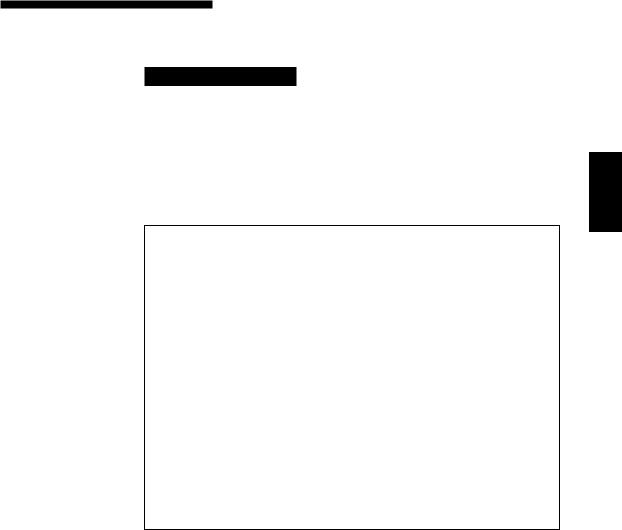
Régles de sécurité
AVERTISSEMENT
Afin d'eviter tout risque d'incendie ou d'électrocution, ne pas exposer cet appareil à la pluie ou à l'humidité.
Afin d'écarter tout risque d'électrocution, garder le coffret fermé. Ne confier l'entretien de l'appareil qu'à un personnel qualifié.
REMARQUE
CETTE REMARQUE NE CONCERNE QUE LES ETATS-UNIS ET
CANADA.
En cas d'envoi aux Etats-Unis, n'utiliser que le cordon d'alimentation
Inscrit sur LIST UL et spécifié ci-dessous pour utilisation sur 220-240 V.
En cas d'envol au CANADA, n'utiliser que le cordon d'alimentation
CERTIFIE par CSA et spécifié ci-dessous pour utlilsation sur 220-240 V.
N'UTILISER AUCUN AUTRE CORDON D'ALIMENTATION
Fiche |
Lame tandem avec une broche de mise à la terre. |
|
(Configuration NEMA 6-15P) |
Cordon |
Type SVT ou SJT, trois fils 16 ou 18 AWG. |
Longeur |
Maximum 14.7 pieds (4.5m) |
Capacité |
Minimum 10A, 250 V |
Français
29
